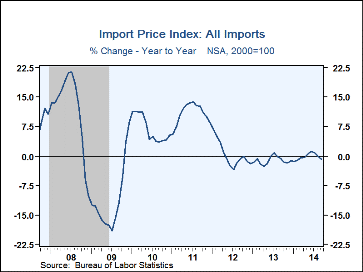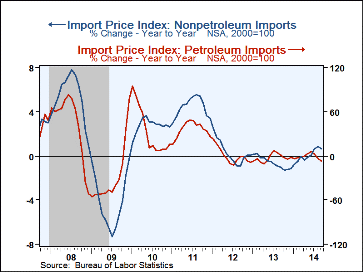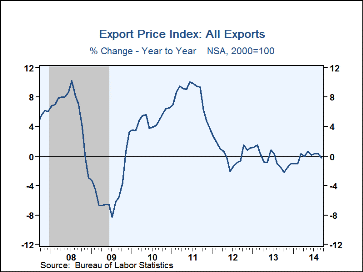 Global| Oct 10 2014
Global| Oct 10 2014U.S. Import Prices Decline
by:Tom Moeller
|in:Economy in Brief
Summary
Import prices fell 0.5% (-0.9% y/y) during September, after a 0.6% August drop, earlier reported as -0.9%. The decline matched expectations in the Action Economics Forecast Survey. A 2.0% fall (-6.6% y/y) in petroleum prices led the [...]
Import prices fell 0.5% (-0.9% y/y) during September, after a 0.6% August drop, earlier reported as -0.9%. The decline matched expectations in the Action Economics Forecast Survey. A 2.0% fall (-6.6% y/y) in petroleum prices led the decline in import costs. That was accompanied by a 0.2% slip (+0.7% y/y) in nonoil prices.
Last month's drop in nonoil import prices reflected a 0.4% shortfall (+2.0% y/y) in nonoil industrial supplies prices, the fifth decline in the last six months. Motor vehicle & parts prices slipped 0.1% (-0.7% y/y) while nonauto consumer goods priced were unchanged (0.9%), as they have been during the last five months. Capital goods prices also were unchanged (0.2% y/y) for the third straight month but prices for foods, feeds & beverages gained 0.2% (2.9% y/y).
Export prices fell 0.2% (-0.2% y/y) after a 0.5% decline. No change had been expected. A 2.7% drop (-1.7% y/y) in foods, feeds & beverage prices was the fourth consecutive month of decline. Industrial materials prices fell 0.5% (-1.5% y/y) as petroleum & product prices slipped 0.2% (-5.5% y/y). That added to a 2.8% August decline. Nonauto consumer goods prices were off 0.2% (+0.6% y/y) while motor vehicle & parts prices slipped 0.1% (+0.5% y/y). Capital goods prices ticked 0.1% higher (0.8% y/y) following no change during August.
What Predicts U.S. Recessions? from the Federal Reserve Bank of New York is available here.
The import and export price series can be found in Haver's USECON database. Detailed figures are available in the USINT database. The expectations figure from the Action Economics Forecast Survey is in the AS1REPNA database.
| Import/Export Prices (NSA, %) | Sep | Aug | Jul | Sep Y/Y | 2013 | 2012 | 2011 |
|---|---|---|---|---|---|---|---|
| Imports - All Commodities | -0.5 | -0.6 | -0.3 | -0.9 | -1.1 | 0.3 | 10.9 |
| Petroleum | -2.0 | -2.8 | -1.5 | -6.6 | -2.6 | -0.3 | 36.5 |
| Nonpetroleum | -0.2 | 0.0 | 0.0 | 0.7 | -0.6 | 0.3 | 4.5 |
| Exports - All Commodities | -0.2 | -0.5 | 0.1 | -0.2 | -0.4 | 0.4 | 8.1 |
| Agricultural | -0.9 | -3.0 | -1.8 | -2.9 | 1.7 | 2.4 | 22.3 |
| Nonagricultural | -0.2 | -0.2 | 0.3 | 0.0 | -0.7 | 0.1 | 6.6 |
Tom Moeller
AuthorMore in Author Profile »Prior to joining Haver Analytics in 2000, Mr. Moeller worked as the Economist at Chancellor Capital Management from 1985 to 1999. There, he developed comprehensive economic forecasts and interpreted economic data for equity and fixed income portfolio managers. Also at Chancellor, Mr. Moeller worked as an equity analyst and was responsible for researching and rating companies in the economically sensitive automobile and housing industries for investment in Chancellor’s equity portfolio. Prior to joining Chancellor, Mr. Moeller was an Economist at Citibank from 1979 to 1984. He also analyzed pricing behavior in the metals industry for the Council on Wage and Price Stability in Washington, D.C. In 1999, Mr. Moeller received the award for most accurate forecast from the Forecasters' Club of New York. From 1990 to 1992 he was President of the New York Association for Business Economists. Mr. Moeller earned an M.B.A. in Finance from Fordham University, where he graduated in 1987. He holds a Bachelor of Arts in Economics from George Washington University.










